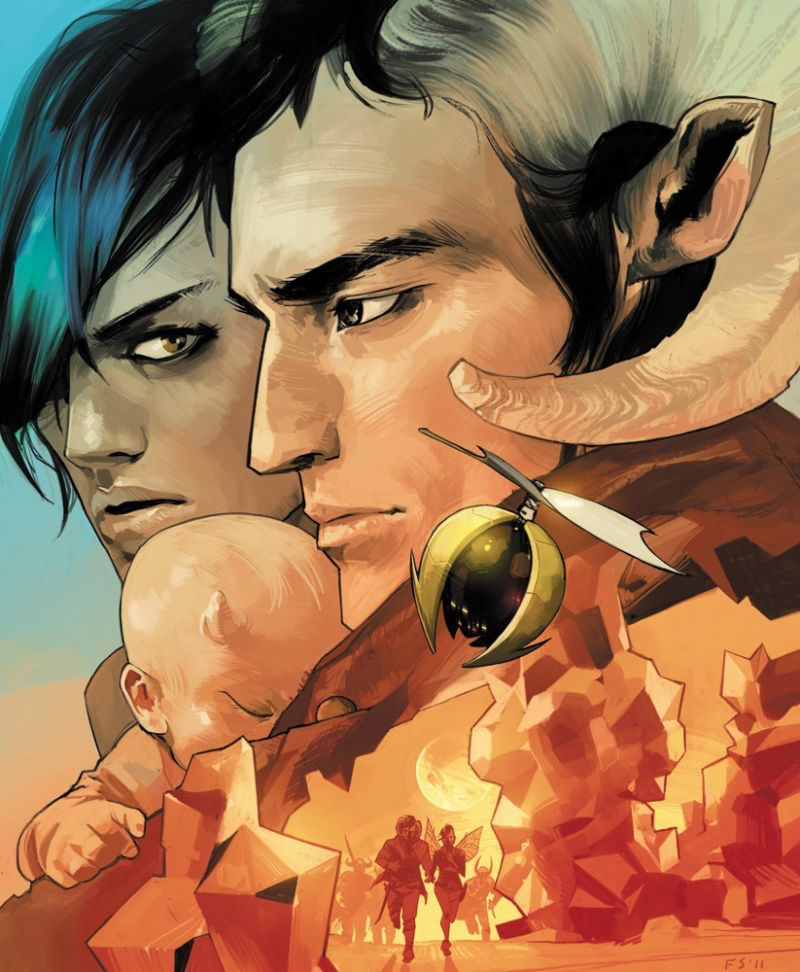Comic Corner: Review of ‘Saga’ series

(Courtesy of Image Comics, Inc.)
By Matthew Fernandez
Jan. 24, 2017 10:06 p.m.
Comics embody the marriage of art and literature, bridging together two mediums into an engaging storytelling form. In Comic Corner, Daily Bruin A&E will celebrate the literary importance of comic series through stories about comic books, comic shops and comic lovers.
Imagine “Romeo and Juliet” set in space.
The largest planet in the galaxy and its moon are at war. Rather than destroying their own worlds, the two races outsource their intergalactic battle to other planets and drag the native species into their conflict.
This is the dark world of the comic series “Saga.”
First published in 2012 by Brian K. Vaughan and Fiona Staples, the bold comic series does not shy away from adult themes or social commentary, making it a compelling series to follow.
The comic series tells the story of Alana and Marko, two aliens who fall in love despite an intergalactic war between their races, as told from the perspective of their hybrid daughter, Hazel. Considered an abomination by galactic authorities, Hazel and her family must flee both the war and the endless stream of characters trying to capture or kill them.
The story is engrossing and creates a sense of investment through its rich world-building and outlandish plot. At one point, Alana takes a tree rocket to another planet and becomes a soap opera star. Hazel’s narration of the story as an adult looking back on the events also provides a personal commentary, making it easier to sympathize with her family’s exploits.
[Related: Comic Book Review: ‘Mortal Kombat X #12′]
Characters feel complex and multifaceted due to their ever-shifting personalities, and unexpected twists keep readers guessing about how the different characters will interact and which ones will die next.
“Saga’s” main characters undergo growth through rich character arcs in which they fall in and out of love, suffer the deaths of loved ones and lose all sense of identity. By allowing the readers to accompany the characters during their misfortunes both through the story and pictures, Vaughan and Staples create empathy for even the most despicable characters.
For example, a freelance mercenary known as The Will suffers the deaths of his lover and sister, has his pet abandon him, becomes addicted to drugs and alcohol and gets his mercenary license revoked. While The Will begins the series as a proud and ruthless killer, he devolves into a directionless, hollow shell. Such character dynamism shows the strength of Vaughan’s writing and the versatility of his characters, while the tragedy makes characters like The Will more relatable.
Another of “Saga’s” strengths is Staples’ intricate artwork. Each issue is full of detailed and diverse designs for alien species, ranging from organic robots with televisions for heads to human-spider hybrids, along with its wonderfully visceral depictions of violence and sex, including full-page nudity, such as Issue 7’s graphic illustration of an obese, naked giant.
The artwork alone makes the series worth reading and accomplishes Staples and Vaughan’s goal of making the comic unfilmable. Vaughan said part of “Saga’s” bold content is intended to dissuade filmmakers from trying to adapt the series into a cinematic medium.
Through the emphasis on adult themes in the series, Vaughan and Staples challenge the belief that comic books are trivial stories meant for children. “Saga” is clearly intended for a mature, adult audience as seen by its artwork and story. Graphic imagery of sex between two men resulted in its temporary ban on some platforms, like the comiXology app.
“Saga” also delves into controversial and political topics, such as the LGBTQ community, race relations and the damaging effects of war. Its pointed yet respectful treatment of current civil rights issues, such as making interspecies couples a norm, is a welcome and necessary break from the often frivolous and apolitical titles that flood comic book stores.
The comic is praiseworthy for its diversion from the traditional American comic tradition of straight, white male story arcs. While its content could be criticized for being overly liberal, its messages of love and acceptance have much to teach the world, especially in such divisive times.
[Related: Creator-owned comic series show individuality, provide fresh ideas]
However, in some instances, “Saga’s” wealth of content turns into a weakness. As the comic progresses, its many plot lines and story arcs intermittently flow in and out of the main story in such a way that it feels like Vaughan does not have a concrete plan for the series and is making much of it up as he goes along. Many characters are introduced and killed off quickly, prohibiting the audience from connecting to characters other than the main cast.
Although its mature content and visceral artwork may be initially off-putting to some, especially readers who are new to comic books, “Saga’s” depth and imagination make it a compelling read.
Its multilayered story, dynamic characters, intricate artwork and fearless handle on controversial topics demonstrate the potential of the comic book medium.


